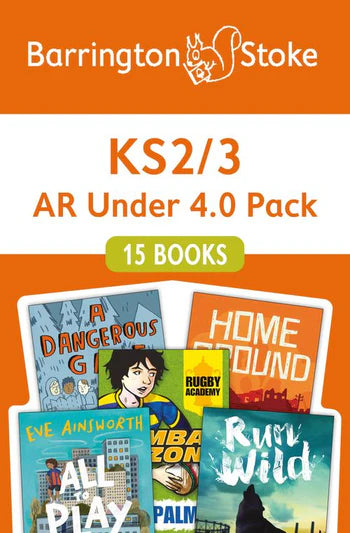
This unique pack targets readers in upper primary and lower secondary who are reading books levelled below AR Level 4.0.
- Imprint: Barrington Stoke }
- ISBN: 978‑0‑00‑874175‑4
- Reading‑age target: Books levelled at **AR 4.0 and under** (Accelerated Reader level)
- Interest age: Upper primary to lower secondary (approx. age 9‑14)
- Contents: A bundle of 15 (or more) paperback titles (total pages ~1344) including short‑text stories suitable for older children who are still developing reading confidence.
- Design features: Short chapters, accessible layout, black & white illustrations, themes appropriate for secondary interest but with reading demands reduced.
- Use case: Excellent for reading‑for‑pleasure libraries, reading interventions, SEN support, paired reading programs and home reading for older children with lower reading ability.
FAQs
Q1. Is this pack suitable for older children with dyslexia or low reading ages?
Yes — the pack is specifically targeted at readers who are in upper primary or lower secondary (ages ~9‑14), but whose reading age is low (AR 4.0 or below). The design and content aim to keep them engaged while supporting reading confidence.
Q2. What age group is this pack aimed at?
The interest age is around 9–14 (Key Stage 2 & 3), making it suitable for upper primary and early secondary learners who need accessible texts.
Q3. How many titles are included?
The pack includes 15 paperback titles (as per the publisher listing) with combined total pages ~1344.
Q4. Can this be used in classroom or intervention settings?
Absolutely. It is designed for settings where students benefit from age‑appropriate content length with manageable reading demands — such as reading‑for‑pleasure libraries, SEN support groups, paired‑reading, and inclusive classrooms.
Q5. Are the stories simplified or juvenile?
Not merely juvenile — the stories are age‑appropriate in theme and interest for older children, but the reading demands (vocabulary, text length) are reduced or presented in accessible layout so that learners aren’t held back by format. This enables older readers with reading difficulties to engage with stories that reflect their age, not younger ones.







